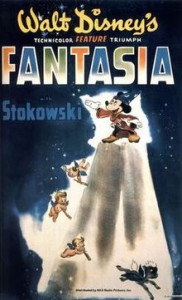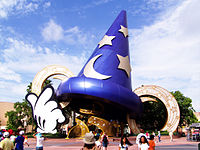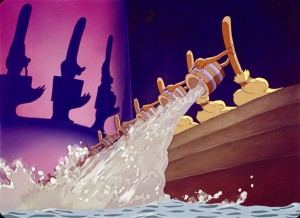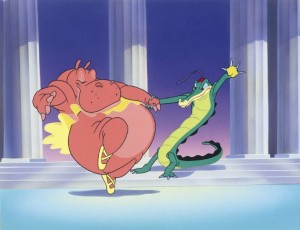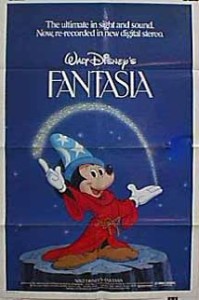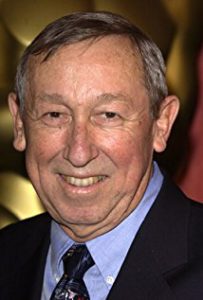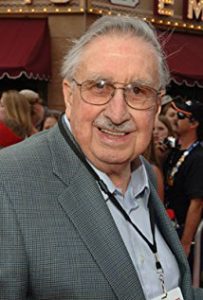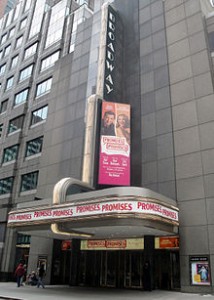Fantasia ***** (1940, Walt Disney) – Classic Movie Review 1250
Walt Disney’s inspired 1940 feature film cartoon masterpiece, comprising eight animated sequences illustrating a piece of popular classical music, is still a magical experience.
The highlights include Mickey Mouse trying to hold the water back in Paul Dukas’s ‘Sorcerer’s Apprentice’, the surreal images to Johann Sebastian Bach’s ‘Toccata and Fugue in D Minor’, the elephants’ ballet to Amilcare Ponchielli’s ‘La Giaconda: Dance of the Hours’ and the prehistoric sequence for Igor Stravinski’s ‘Rite of Spring’ .
Plus there is Modest Mussorgsky’s ‘A Night on Bald Mountain’ and Pyotr Ilych Tchaikovsky’s ‘Nutcracker Suite’. Arguably, the slight let-downs are Beethoven’s 6th Pastorale symphony and the Franz Schubert ‘Ave Maria’ sections
For many years it had a claim to being perhaps Disney’s most successful film artistically and critically, though now with so many subsequent Disney animation triumphs to chose from it’s hard to say if that is still true.
The music is conducted by Leopold Stokowski and seven of the animated segments are performed by the Philadelphia Orchestra.
Music critic and composer Deems Taylor acts as the film’s Master of Ceremonies and introduces each segment in live action scenes.
With story direction by Joe Grant and Dick Huemer and production supervision by Ben Sharpsteen, it is the third feature in the series of Disney animated features.
The soundtrack was recorded using multiple audio channels and reproduced with Fantasound, a pioneering sound reproduction system that made Fantasia the first commercial film shown in stereophonic sound.
As production costs The Sorcerer’s Apprentice, an elaborate Silly Symphonies short designed as a comeback role for Mickey Mouse, grew higher than what it could earn, Walt Disney decided to include the short in a feature-length film with other segments set to classical music.
It initially made a loss as World War two cut off the profitable European market, which would have offset the film’s high production costs and the expense of leasing theatres and installing the Fantasound equipment for the roadshow presentations. It was known as Uncle Walt’s Folly.
But he had the last laugh. After being re-released many times, by 2012, Fantasia has grossed $76.4 million in domestic revenue and is the 22nd highest-grossing film of all time in the US when adjusted for inflation. And the mixed reviews of 1940 had turned to wide acclaim.
It was beautifully restored in 1990 in a version that runs 124 minutes.
Disney had wanted Fantasia to be an on-going project, with a new edition being released every few years. His plan was to substitute one of the original segments with a new one as it was complete, so the viewer would always see a new version of the film.
Finally, Roy Edward Disney, the nephew of Walt, co-produced Fantasia 2000, which entered production in 1990 and features seven new segments performed by the Chicago Symphony Orchestra with conductor James Levine. Only Mickey Mouse in Paul Dukas’s ‘The Sorcerer’s Apprentice’ remains from the original film.
Fantasia 2000 premiered at Carnegie Hall on December 17 1999 as part of a five-city live concert tour, followed by a four-month engagement in IMAX cinemas and a wide release in regular theatres in 2000.
Roy Edward Disney died on 16 aged 79.
Xavier Atencio, legendary Disney animator and imagineer, died on 10 September 2017, aged 98. He was an assistant animator on Fantasia.
© Derek Winnert 2014 Classic Movie Review 1250
Link to Derek Winnert’s home page for more film reviews: http://derekwinnert.com/

Walt Disney acts out a scene in Fantasia’s The Sorcerer’s Apprentice for Deems Taylor and Leopold Stokowski.

Fantasia’s grand premiere at Hollywood’s Carthay Circle Theatre on 30 January 1940 attracted 5000 people, including Shirley Temple, Cecil B DeMille, Forrest Tucker, James Cagney and Robert Montgomery.

